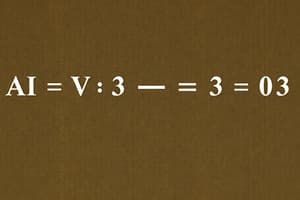Podcast
Questions and Answers
Which of the following statements about assets is true?
Which of the following statements about assets is true?
- Short-term assets are often utilized for long-term production.
- Non-current assets generate benefits over multiple years. (correct)
- Current assets are expected to provide benefits over many years.
- Intangible assets are not classified as financial assets.
What defines a liability according to the Conceptual Framework?
What defines a liability according to the Conceptual Framework?
- A potential resource that can generate future cash flows.
- A current asset that cannot be converted into cash.
- An obligation to pay current assets on credit.
- A present obligation resulting from past events to transfer an economic resource. (correct)
Which of the following is classified as a current liability?
Which of the following is classified as a current liability?
- Amounts owed to suppliers that need to be paid within the year. (correct)
- A bank loan that will be repaid in 15 months.
- Corporate bonds issued with maturity of ten years.
- Debts due for payment in more than one year.
Which asset is least likely to be classified as a non-current asset?
Which asset is least likely to be classified as a non-current asset?
What is a significant characteristic of intangible assets?
What is a significant characteristic of intangible assets?
What amount represents Charlie's total assets before trading begins on 3 July 20X6?
What amount represents Charlie's total assets before trading begins on 3 July 20X6?
What is the total value of Charlie's liabilities before trading starts?
What is the total value of Charlie's liabilities before trading starts?
What distinguishes a limited liability company from a sole trader in terms of liability for debts?
What distinguishes a limited liability company from a sole trader in terms of liability for debts?
How is the profit from the sale of flowers classified in accounting terms?
How is the profit from the sale of flowers classified in accounting terms?
What is Charlie's retained profit after selling the flowers for CU 900?
What is Charlie's retained profit after selling the flowers for CU 900?
How does the law treat a company compared to an individual sole trader?
How does the law treat a company compared to an individual sole trader?
What is the business entity concept?
What is the business entity concept?
What will be the total amount of capital after Charlie retains the profit?
What will be the total amount of capital after Charlie retains the profit?
Which of the following best describes the accounting treatment for assets in Charlie's business?
Which of the following best describes the accounting treatment for assets in Charlie's business?
In the event of insolvency, how are the owners of a limited liability company affected compared to a sole trader?
In the event of insolvency, how are the owners of a limited liability company affected compared to a sole trader?
What is the cash position of Charlie after the sales transaction is completed?
What is the cash position of Charlie after the sales transaction is completed?
What happens if a sole trader's business debts exceed its business assets?
What happens if a sole trader's business debts exceed its business assets?
Which of the following best describes the relationship between a company's assets and liabilities according to accounting principles?
Which of the following best describes the relationship between a company's assets and liabilities according to accounting principles?
Which equation represents the relationship using Charlie's accounting terms after the trading?
Which equation represents the relationship using Charlie's accounting terms after the trading?
If Charlie had paid CU 800 for the stall instead of CU 1,800, what would the new total capital be after the first sale?
If Charlie had paid CU 800 for the stall instead of CU 1,800, what would the new total capital be after the first sale?
Which situation reflects the legal reality of a limited liability company's ability to incur debts?
Which situation reflects the legal reality of a limited liability company's ability to incur debts?
What defines a trade payable in a business context?
What defines a trade payable in a business context?
What happens to a trade payable when the debt is settled?
What happens to a trade payable when the debt is settled?
In the example where Cedar sells goods to Diggy on credit, what is the nature of the relationship?
In the example where Cedar sells goods to Diggy on credit, what is the nature of the relationship?
What is the typical payment term for trade payables as mentioned?
What is the typical payment term for trade payables as mentioned?
How is a trade receivable categorized in a business's financial statements?
How is a trade receivable categorized in a business's financial statements?
Which of the following best describes the role of a trade creditor?
Which of the following best describes the role of a trade creditor?
When a business issues an invoice for credit sales, what is the expected outcome for trade receivables?
When a business issues an invoice for credit sales, what is the expected outcome for trade receivables?
What does it indicate when a business delays a payment for goods purchased on credit?
What does it indicate when a business delays a payment for goods purchased on credit?
Which of the following transactions would NOT affect trade payables?
Which of the following transactions would NOT affect trade payables?
Flashcards
Economic Resource
Economic Resource
A right that has the potential to produce economic benefits.
Asset
Asset
An item owned by a business with a future economic benefit.
Non-Current Asset
Non-Current Asset
An asset that is expected to generate economic benefits for more than a year.
Current Asset
Current Asset
Signup and view all the flashcards
Liability
Liability
Signup and view all the flashcards
Legal entity
Legal entity
Signup and view all the flashcards
Limited liability
Limited liability
Signup and view all the flashcards
Sole trader liability
Sole trader liability
Signup and view all the flashcards
Business entity concept
Business entity concept
Signup and view all the flashcards
Accounting equation
Accounting equation
Signup and view all the flashcards
Liabilities
Liabilities
Signup and view all the flashcards
Accounting Equation for a New Business
Accounting Equation for a New Business
Signup and view all the flashcards
Balance Sheet
Balance Sheet
Signup and view all the flashcards
Capital
Capital
Signup and view all the flashcards
Profit
Profit
Signup and view all the flashcards
Retained Profit
Retained Profit
Signup and view all the flashcards
Rearranging the Accounting Equation to Calculate Capital Balance
Rearranging the Accounting Equation to Calculate Capital Balance
Signup and view all the flashcards
Historical Cost
Historical Cost
Signup and view all the flashcards
Trade Payable
Trade Payable
Signup and view all the flashcards
Creditor
Creditor
Signup and view all the flashcards
Trade Payable: Liability
Trade Payable: Liability
Signup and view all the flashcards
Trade Receivable
Trade Receivable
Signup and view all the flashcards
Debtor
Debtor
Signup and view all the flashcards
Trade Receivable: Asset
Trade Receivable: Asset
Signup and view all the flashcards
Capital Increase
Capital Increase
Signup and view all the flashcards
Liability Increase
Liability Increase
Signup and view all the flashcards
Study Notes
Chapter 2: The Accounting Equation
- This chapter introduces the accounting equation, a fundamental concept in accounting
- The equation states: Assets = Liabilities + Equity (or Capital)
- Assets are resources controlled by the entity that have future economic benefits
- Liabilities are present obligations of the entity to transfer an economic resource as a result of past events
- Equity (or Capital) represents the residual interest in the assets of the entity after deducting all its liabilities
- The equation ensures balance and accuracy in accounting records
- The accounting equation reflects the financial position of a business at a specific point in time.
- Assets, liabilities and equity are key elements of financial statements
- Assets are tangible / intangible; current or non-current
- Liabilities are current or non-current; trade payables / loans
- Equity includes capital brought in by the owner
Business Entity Concept
- A business is treated as a separate entity distinct from its owners from an accounting viewpoint
- This means business transactions are recorded independently from the owner's personal finances
- Regardless of legal structure (sole proprietorship, partnership, or corporation)
- Crucial for tracking financial performance specific to the business
Assets
- Definition: A present economic resource controlled by the entity that has potential to produce economic benefit
- Examples: Cash, Accounts Receivable, Inventory, Land, Buildings, Equipment
- Current Assets: Expected to be converted to cash or used up within one year
- Non-Current Assets: Used in the business for more than one year
Liabilities
- Definition: A present obligation of the entity to transfer an economic resource as a result of a past event.
- Examples: Accounts Payable, Salaries Payable, Loans Payable
- Current Liabilities: Expected to be settled within one year
- Non-Current Liabilities: Expected to be settled in more than one year
Equity (or Capital)
- Definition: The residual interest in the assets of the entity after deducting all its liabilities
- Represents the owner's investment in the business
- Increases with profits, decreases with losses or drawings
- Can be viewed as a measure of the owner's investment in the business
Statement of Financial Position
- A snapshot of a company's financial position on a particular date,
- Shows assets, liabilities and equity
- Calculated using the accounting equation (Assets = Liabilities + Equity)
Statement of Profit or Loss
- Summarizes a company's financial performance over a period of time
- Shows revenues and expenses to determine profit or loss
- Revenues—Amounts earned from sales or services
- Expenses—Costs associated with generating revenue
- Includes distribution, administrative and finance costs
- Profit = Revenue – Expenses
Depreciation
- The process of allocating the cost of a non-current asset over its useful life
- Represents the consumption of the asset over time
- Recorded in the statement of profit or loss
Studying That Suits You
Use AI to generate personalized quizzes and flashcards to suit your learning preferences.



